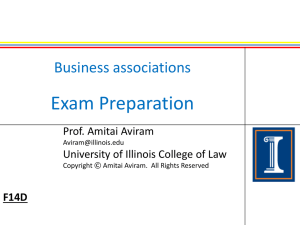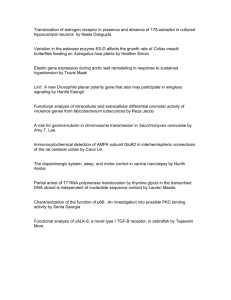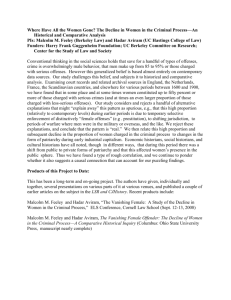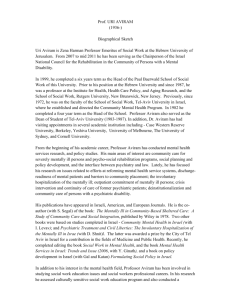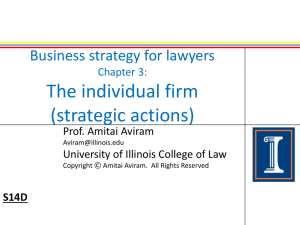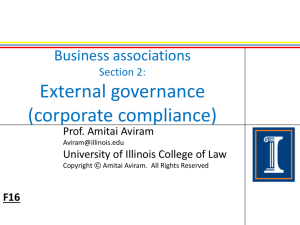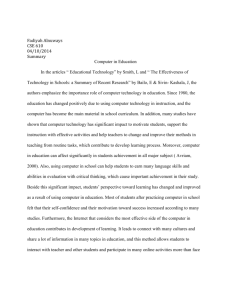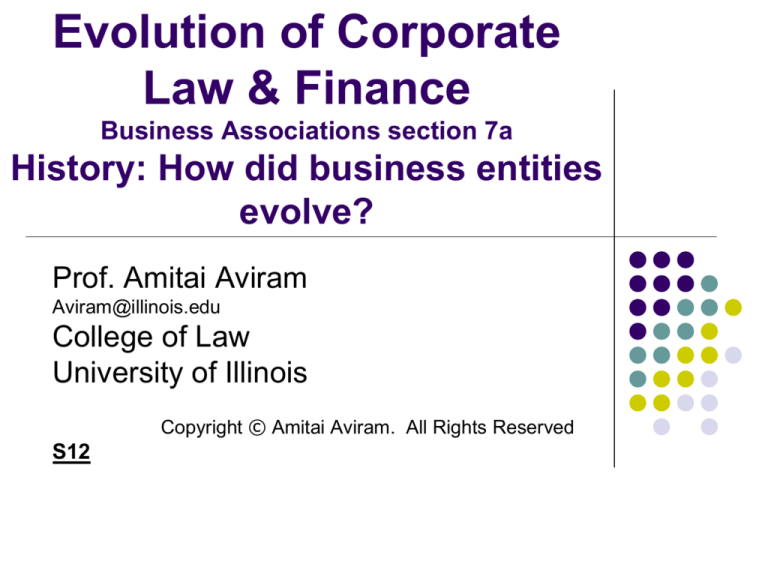
Evolution of Corporate
Law & Finance
Business Associations section 7a
History: How did business entities
evolve?
Prof. Amitai Aviram
Aviram@illinois.edu
College of Law
University of Illinois
Copyright © Amitai Aviram. All Rights Reserved
S12
History
Overview of Section 7a
1.
Course overview
2.
3.
4.
Administrative details of the course
Writing a research paper
Economic and legal history methodologies
Pre-capitalist economic systems
Commercial capitalism
Industrial capitalism
© Amitai Aviram. All rights reserved.
2
How is this seminar different
from other classes I teach?
Less practitioner-oriented
Most of my classes put you in the corporate lawyer’s seat
Unfortunately, few clients are willing to pay for a thoughtful
historical survey of corporate law
But understanding the history & economics of law’s
development will help you understand the law better & come
up with clever legal arguments
Copyright © Amitai Aviram. All Rights Reserved
3
How is this seminar different
from other classes I teach?
Much less lecture; much more discussion
Require you to actively talk in class
More reading than in most of my classes
Because discussion responsibilities are significant
Paper length requirement is very modest
Required to lead discussion only in designated classes
Copyright © Amitai Aviram. All Rights Reserved
4
How is this seminar different
from other classes I teach?
Much less lecture; much more discussion
Typical class structure
First 20 minutes: I lecture, laying the background to the
issue we are discussing
Remaining time: Discussion leaders present & moderate
discussion
Review the assigned reading material
Highlight questions/observations that arose from the material
Pose questions to the rest of the class
Other students are expected to add their own
thoughts/insights/questions
Copyright © Amitai Aviram. All Rights Reserved
5
PowerPoint slides
PowerPoint Slides, reading assignments and syllabus are all
posted and regularly updated on my website
http://www.law.illinois.edu/aviram/
Date of slides marked on
bottom left of the first slide
F07D: Fall 2007 – Draft
F07: Fall 2007 – Final
S07: Spring 2007
Copyright © Amitai Aviram. All Rights Reserved
6
Grading
Research paper
Topic of your choice, as long as it’s related to the course
No minimum or maximum length
Expected length: about 10 pages
Grade adjustments
Up to 1 grade-point up, unlimited adjustment down
However, an upwards or downwards adjustment of more
than ⅓ of a grade point (e.g., from B+ to A-) is rare
Copyright © Amitai Aviram. All Rights Reserved
7
Grading
Grade adjustments
Attendance & participation in class discussion
Discussion leading (team activity)
Presentation of your paper
15-20 minutes (4 students per class)
Conducted in the last classes of the semester
Students present by alphabetical order of their last names,
unless they agree to swap places
Copyright © Amitai Aviram. All Rights Reserved
8
Discussion leading
Coordinating participation
Discussion leading team should coordinate:
Speaking order
Default: by alphabetical order of last names
Which topics/ideas each student will cover
Brainstorming for questions, outside material etc.
Copyright © Amitai Aviram. All Rights Reserved
9
Discussion leading
How to Prepare
Good participation
Read assigned material
Write down insights, puzzles & questions that come up
Brainstorm with the rest of your team
Decide: lecture or lecture/discussion mix?
Lecturing gives you more control, but can be less engaging
Discussion works best when it involves activities (e.g., team work)
or a narrow but not obvious question
Excellent participation
Follow up on your insights & questions by searching for more
relevant material
Copyright © Amitai Aviram. All Rights Reserved
10
Research paper
Your choice of topic, as long as it’s related to the
history of business organizations law or finance
Expected length: ~10 pages (including footnotes)
If you want ULWR credit: 6,000 words (not counting FNs)
Due on the last day of classes in the semester
Clever, innovative thesis
Good execution (substantiating the thesis with evidence)
Submit the paper by e-mail (aviram@illinois.edu)
More about how to write a research paper later
Copyright © Amitai Aviram. All Rights Reserved
11
Talking to me outside of class
Please e-mail prior to meeting with me
Suggest when you would like to meet
(not limited to office hours)
Describe what issues you want to talk
about
E-mail: Aviram@illinois.edu
Room 326
Copyright © Amitai Aviram. All Rights Reserved
12
Writing a research paper
Copyright © Amitai Aviram. All Rights Reserved
13
Writing a research paper
Process
Picking a thesis
1.
a)
b)
2.
3.
4.
Deciding on a topic
Researching the topic to determine the thesis
Writing an outline & abstract
Writing a draft
Polishing
Copyright © Amitai Aviram. All Rights Reserved
14
1. Picking a thesis
The most important part
Thesis is the single most important part of your paper
Everything else exists to:
Explain your thesis
Support your thesis (evidence)
Explain the implications of the thesis (why it is important?)
Copyright © Amitai Aviram. All Rights Reserved
15
1. Picking a thesis
Topic vs. thesis
Topic: A narrow area of law, place and time
Partnerships in Pre-modern China
Limited liability in popular culture in France and England, 1850-1900
Delaware’s Rise to Corporate Law Prominence
Not: “Mergers & Acquisitions”, “Limited Liability Companies”
Borderline: Business Entities in colonial Virginia
Thesis: A claim about something within your topic; E.g.,
Case X should be interpreted in the following way…
The First Amendment is the main reason the American states adopted
general incorporation statutes earlier than most European countries
Muslim law did not independently develop corporate law because…
Business ventures are organized in the following way in virtual worlds…
Copyright © Amitai Aviram. All Rights Reserved
16
1. Picking a thesis
(a) Deciding on a topic
1.
Choose a topic in which you have some competitive
advantage over others in researching. E.g.,
2.
Choose a topic that interests you
3.
Knowledge of methodology
Knowledge of language, culture, law, etc.
It takes a lot of discipline to do adequate research, and it's
easier to gather this discipline when you enjoy the topic you
are researching
Choose a topic that is researchable
I.e., make sure that you are able to access the information
needed for your research
Copyright © Amitai Aviram. All Rights Reserved
17
1. Picking a thesis
(b) Researching the topic to determine the thesis
Thesis can be analytical or synthetic
Analysis: Use various evidence to prove a new claim
Synthesis: Survey others’ analyses regarding the claim
All else equal, analytical theses are better
Good paper w/analytical thesis → Excellent paper
Good paper w/synthetic thesis → Adequate paper
Copyright © Amitai Aviram. All Rights Reserved
18
1. Picking a thesis
(b) Researching the topic to determine the thesis
Analytical thesis should be:
Novel
A claim no one has made before
New type of evidence supporting a disputed claim
Expanding an existing claim to new areas
Non-obvious
Isn’t automatically accepted as true without supporting evidence
Sound (supported by evidence & balanced)
The evidence you present would persuade a reasonable person that
your claim is correct
Rule of thumb: If it sounds like a debate or an op-ed, it’s not “sound”
Copyright © Amitai Aviram. All Rights Reserved
19
1. Picking a thesis
(b) Researching the topic to determine the thesis
Synthetic thesis should be:
Thorough
Fair
All significant relevant sources presented
Each source is accurately presented
Organized
Fit others’ scholarship into categories & patterns
Copyright © Amitai Aviram. All Rights Reserved
20
1. Picking a thesis
Common pitfalls
The over-broad thesis (raises too many sub-issues)
Thesis on a matter that cannot be generalized
Falling in love with your thesis
E.g., Should CEOs be fired for backdating stock options?
Ignoring evidence that thesis is wrong or not novel
Thesis lacks supporting evidence; relies on
persuasion
Remember: This is a research paper, not a brief!
Copyright © Amitai Aviram. All Rights Reserved
21
1. Picking a thesis
Process
Pick a topic (competitive advantage, interest, researchable)
Conduct initial research (at least 5 different sources)
1.
2.
Pick a tentative thesis
3.
Analytical (novel, non-obvious, sound) or synthetic (thorough, fair, organized)?
The “Add/Drop Period” - Focus your research to:
4.
5.
Treatises, legal encyclopedias are a crash course to the law
Law review/SSRN articles flag current debates & “hot issues”
Talk to reference librarians (not only at the law library)
Ensure that the thesis is novel & correct
Fine tune or change the thesis if it’s not novel or not correct
Decide on a final thesis
Copyright © Amitai Aviram. All Rights Reserved
22
1. Picking a thesis
Tips
Start with the narrowest topic and expand if
necessary, rather than the other way around
Taking a contrary position to an established view
almost ensures that your thesis is novel, non-obvious
and important
Pitfalls
Relying on persuasion
Falling in love with the thesis
Copyright © Amitai Aviram. All Rights Reserved
23
1. Picking a thesis
Tips
Most important: Seek your competitive advantage
Copyright © Amitai Aviram. All Rights Reserved
24
2. Writing an outline & abstract
Organizing the logic of your argument
Abstract: Summary of the paper (1-3 paragraphs)
Allows you to briefly describe your paper to someone else
Outline: Title/content of each section and sub-section
The future “Table of Contents” of the paper
Typical depth: 3 levels
Breaks down the research into manageable pieces
Copyright © Amitai Aviram. All Rights Reserved
25
3. Writing a draft
Filling in the outline
Usually start with an introduction that addresses:
What is your thesis?
How is it different from what was written before?
Why it is important?
Outline of the paper’s structure
Focus on each sub-section at a time
Before writing, have an idea of what this sub-section will say
Don’t get bogged down in details at this stage – drop a
footnote or highlight a note to yourself when you need to find
a minor reference/citation
Copyright © Amitai Aviram. All Rights Reserved
26
3. Writing a draft
Primary vs. secondary sources
Sources to support your thesis are divided into:
Primary sources: Sources that are not based on any other
existing source (but may be based on lost sources)
Secondary sources: Sources that are based on an existing
source
Research execution is better the more it relies on
primary sources
Copyright © Amitai Aviram. All Rights Reserved
27
3. Writing a draft
Primary vs. secondary sources
Some sources contain primary & secondary portions
E.g., a court decision describes the history of a rule, leading
it to decide the case in a certain way
Primary source – for the law created by this case
Secondary source – for the history of the rule
Some sources are primary or secondary depending on
the claim they support
E.g., a U.S. court decision addresses French precedents
Primary: for the point that U.S. courts considered French law
Secondary: for the description of the French law on the issue
If your thesis is synthetic, many sources the would otherwise
be considered secondary would be considered primary
Copyright © Amitai Aviram. All Rights Reserved
28
4. Polishing
Final touches
Go over all highlighted notes and fill necessary
references/quotes/text
Re-read your paper
Typos
Grammar
Unnecessary Repetition
Confusing language
Disconnect between sub-sections of your paper
If possible, have a friend read the paper to pick up
places in which you are unclear
Copyright © Amitai Aviram. All Rights Reserved
29
Research paper
Common topics
Case History
Development of legal doctrine X [place, time]
E.g., Development of the BJR in US law in the 20th Century
Development of business technique Y [place, time]
E.g., Behind the scenes of Smith v. Van Gorkom
E.g., SH preemption rights in the UK, 1750-1950
Economic circumstances in period Z, and their impact
on [corporate, partnership, etc.] law
E.g., The effects of the War of 1812 on US corporate law
Copyright © Amitai Aviram. All Rights Reserved
30
Economic & legal history
methodologies
Copyright © Amitai Aviram. All Rights Reserved
31
Evolution of corporate law
Key questions
How did a certain aspect of
corporate law evolve?
Why did this evolution take
place?
Copyright © Amitai Aviram. All Rights Reserved
32
How did a certain aspect of
corporate law evolve?
Factual question
Consider not only the evolution of the law itself, but
also of supporting institutions & business customs
For example, the development of laws governing
shares (e.g., joint stock companies) was limited until:
Partnerships began to allow partners to freely transfer their
partnership (business custom); and
Stock exchanges developed (supporting institution)
Copyright © Amitai Aviram. All Rights Reserved
33
Why did this evolution take place?
Path-dependent explanation
A path-dependent explanation is based on the
argument that the law is a result of a specific event,
person, etc.
Implied arguments
But for the event/person, the law would have been different
If the event had not occurred/ person not been in that
position, a similar event/person would not have emerged
Copyright © Amitai Aviram. All Rights Reserved
34
Why did this evolution take place?
Path-dependent explanation
Example
Early corporations carried out public functions that government
“outsourced” to the private sector (e.g., capturing & controlling new
lands, building turnpikes and railways, raising taxes)
Therefore, early corporations were seen as extensions of the
state, and constitutional law seemed a good analogy
As a result, some aspects of constitutional law were imported into
corporate law
Path-dependent argument: If early corporations had carried
purely private functions (e.g., manufacturing, retailing), certain
concepts imported from constitutional law would not have
become part of corporate law
Copyright © Amitai Aviram. All Rights Reserved
35
Why did this evolution take place?
Structural explanation
A structural explanation points to certain forces that
determine what law emerges, and demonstrates how
the equilibrium of these forces resulted in the law
being the way it is
Implied arguments
Forces mentioned are the ones that matter
If a given event/person were removed, another event/person
would have eventually caused the same results
Copyright © Amitai Aviram. All Rights Reserved
36
Why did this evolution take place?
Structural explanation
Reconsidering the constitutional law influences
example, a structural explanation could argue the
following points:
Early corporations had to have quasi-public functions,
because it made no sense for a private firm to become a
corporation [I think this argument is wrong]
Once corporations with private functions became common,
corporate law shifted to borrowing less from constitutional
law, and that law’s influence on corporate law has diminished
Corporations pose the same political threats as governments
(or pose the same agency problem), and therefore
constitutional law is a good analogy, regardless of the
character of early corporations
Copyright © Amitai Aviram. All Rights Reserved
37
Structure of course material
History: eras of biz org evolution
Law: what are the main legal traits of the corporation and how
did they develop?
Regulation of financial transactions (e.g., lending)
The corporate entity (legal personality & limited liability)
Corporate governance (centralized management & investor ownership)
Evolution: what forces shape modern corporate law?
Pre-capitalist
Commercial capitalism
Industrial capitalism
Corporate law & the business cycle
Regulatory competition
Legal origins (path dependence)
The future of business organizations
Copyright © Amitai Aviram. All Rights Reserved
38
History
Overview of Section 7a
1.
2.
Course overview
Pre-capitalist economic systems
3.
4.
Overview of our theoretical framework
The guild: pre-capitalist manufacturing
The manor: pre-capitalist agriculture
Commercial capitalism
Industrial capitalism
© Amitai Aviram. All rights reserved.
39
Evolution of business entities
Theoretical framework
Why do we have certain business entities when we
do, and why do they change?
Copyright © Amitai Aviram. All Rights Reserved
40
Theoretical framework
What do biz entities do?
The goal of business entities is to facilitate the
interaction between people who possess the
resources needed for the business
Business ideas (entrepreneur)
Money (shareholders, creditors)
Management skills (managers)
Other skills (employees)
Copyright © Amitai Aviram. All Rights Reserved
41
Theoretical framework
Biz entity vs. contract
The same can be done by contract
In fact, the same IS typically done by contract re:
Money (lending agreements)
Management & other skills (employment contract)
Copyright © Amitai Aviram. All Rights Reserved
42
Theoretical framework
Biz entity vs. contract
The use of a business entities
(rather than contracts) benefits
from economies of scale
Contracts are easily tailored to
specific needs of parties
But if there are many parties
involved, managing all the
relationships is very complex
Copyright © Amitai Aviram. All Rights Reserved
43
Theoretical framework
Biz entity vs. contract
Example 1: Small bakery requires 2 employees, no
manager, 1 person to finance business
If organized as a firm: 3 relationships (2+1)
If organized as a set of contracts: 2 relationships (2x1)
2 employment contracts w/financier; or
2 lending agreements w/employees
Example 2: Mid-size steel plant requires 100
employees, 10 managers, 10 people to finance
If organized as a firm: 120 relationships (100+10+10)
If organized as a set of contracts: 10,000 relationships
(100x10x10)
Copyright © Amitai Aviram. All Rights Reserved
44
Theoretical framework
Biz entity vs. contract
Bottom line
In small businesses, a simple lending contract (financier is a
creditor) may be more attractive than using a standardized
business entity (financier is a partner/shareholder)
The larger the business, the more complex it becomes to use
only contracts to manage the parties relationships
The historical pattern
As markets served by businesses grow, the business
becomes larger and involves more parties
This forces the parties to shift from contracts to entities &
requires new forms of business entities to develop
Copyright © Amitai Aviram. All Rights Reserved
45
Theoretical framework
What makes markets grow?
Ag Tech
Trans Tech
Com Tech
Efficient,
reliable
energy
Food Surplus /
Pop. Density
Food Surplus (+)
Population Density (-)
Capital/Labor
Ratio
Fast, Cheap
Movement of
Info & Goods
Efficient,
continuous
production
Market
Size
Scale of
Production
Capital
Intensity
Business
Entity Law
Mil Tech
Security
Copyright © Amitai Aviram. All Rights Reserved
46
Theoretical framework
Structures of business integration
Market
Association
Individuals act independently; contract with each other to
integrate their activities
E.g., farmer’s market
Individuals each profit separately, but association enforces
rules that all of them must follow
E.g., Guild; analogy: condo
Enterprise
Enterprise makes the profit, not individuals separately;
enterprise tells individuals what to do
E.g., corporation
Copyright © Amitai Aviram. All Rights Reserved
47
Theoretical framework
Structures of business integration
Operation
Enterprise
Incentives (prices)
Group decision
Control (hierarchy)
Each individual motivated by market prices, but can’t be
ordered to act (high-powered incentives)
Association
Association
Market
Market
Group reaches a decision that is enforced on all members
Enterprise
Boss has authority to tell employees how to act (highpowered control)
Copyright © Amitai Aviram. All Rights Reserved
48
Theoretical framework
Structures of business integration
Response to change
Market
Association
Enterprise
Fast
Slow
So-so
(autonomous adaptation)
Market
Association
Each individual makes own decision; so, quick response
Need to form consensus/members may try to block/veto
Slow response (especially if members affected differently)
Enterprise
Boss decides for the enterprise; other employees have no
authority to act even if they spot a change
Copyright © Amitai Aviram. All Rights Reserved
49
Theoretical framework
Structures of business integration
Collective action
Market
Association
Enterprise
Poor
Good
So-so
(coordinated adaptation)
Market
Association
Individuals have incentive to shirk and let others undertake
the necessary actions (e.g., pollution controls)
Group can enforce on all members behavior that is in the
collective’s best interests
Enterprise
Because enterprise includes multiple individuals, its share of
action’s benefits is likely larger, so more likely to undertake
the action
Copyright © Amitai Aviram. All Rights Reserved
50
Theoretical framework
Structures of business integration
Agency problem
Enterprise
Low
So-so
High
Each individual reaps 100% of profits from her efforts
Association
Association
Market
Market
Member may benefit from inefficient rules that harm other
members more than herself
Enterprise
Employees’ benefits not necessarily tied to enterprise’s wellbeing or to their own efforts
Copyright © Amitai Aviram. All Rights Reserved
51
Theoretical framework
Structures of business integration
Dependence/fragility
Enterprise
High
Medium
Low
If others exit/never enter the market, individual is stuck
E.g., steel plant dependent on market purchases of coal
Association
Association
Market
Market
Association can mandate rules that maintain stability, but
members may defect
Enterprise
Necessary activities done in-house; less dependence on others
Copyright © Amitai Aviram. All Rights Reserved
52
Theoretical framework
Structures of business integration
Market
Operation
Association
Incentives Group decision
Enterprise
Control
Autonomous adaptation
Fast
Slow
So-so
Coordinated adaptation
Poor
Good
So-so
Agency problem
Low
So-so
High
Dependence/fragility
High
Medium
Low
In this course we will focus on enterprise-type of business
integration, though we will occasionally look at associations
Copyright © Amitai Aviram. All Rights Reserved
53
Periods of business development
Period 0: Insular
• Very low capital intensity; no specialization; sporadic
bartering
Small-scale
Biz Entity
Large-scale
Biz Entity
___
Tribe; Village
Copyright © Amitai Aviram. All Rights Reserved
54
Periods of business development
Period 1: Pre-capitalist
Low capital-intensity; specialization/professionalization;
constant trading
Small-scale
Biz Entity
Large-scale
Biz Entity
Family; General partnership
Manor; Guild
Copyright © Amitai Aviram. All Rights Reserved
55
Periods of business development
Period 2: Commercial capitalism
Medium capital-intensity; capital & labor split; more risktaking
Small-scale
Biz Entity
Sea Loan; Limited partnership
Large-scale
Biz Entity
Regulated company; Chartered corp.;
Joint stock company
Copyright © Amitai Aviram. All Rights Reserved
56
Periods of business development
Period 3: Industrial capitalism
High capital-intensity; factories; mass production &
distribution
Small-scale
Biz Entity
Large-scale
Biz Entity
Limited liability company
Business trust; Business corporation
Copyright © Amitai Aviram. All Rights Reserved
57
Periods of business development
Period 4: What next?
Will even larger markets change our business entities?
Small-scale
Biz Entity
???
Large-scale
Biz Entity
???
Copyright © Amitai Aviram. All Rights Reserved
58
Evolution of business entities
Very rough chronology
Period 0: Insular (-1,000,000)
Period 1: Pre-capitalism (-3000)
Period 2: Commercial capitalism (1500)
Period 3: Industrial capitalism (1750)
Period 4: What next?
Copyright © Amitai Aviram. All Rights Reserved
59
Period 0: Insular
Hunter-gatherer economy
Can sustain only low population density
Tragedy of the commons
Tribes fight viciously to remove rivals
Very high variance in food surplus
No tribe has power to exclude others from land
Result: over-hunting; extinction of animals
Very low security
Need a lot of hunting/foraging land to get food
In good times food spoils, in bad times tribe starves
Slow, expensive movement of goods & information
Copyright © Amitai Aviram. All Rights Reserved
60
Period 0: Insular
Consequences to business
Specialization is suicidal
Trade is sporadic
Everyone needed to collect food
Relying on another tribe to provide a needed good is irrational
Killing other tribe makes more long-term sense than trading with it
Lack of specialization means everyone produces same few goods
(food, basic tools, clothes), so not much to trade
Money & inter-tribe collaboration are rare
Why acquire money when you can’t eat it and there are not many
opportunities to trade?
Why collaborate with a rival tribe whose survival threatens you?
Copyright © Amitai Aviram. All Rights Reserved
61
From Period 0 to Period 1
Early ancient agriculture
Irrigation, but no fertilizing, few crops, no use of animals
Lower variance in food surplus
But low crop yields
At mercy of weather, but more predictable yields
Just barely enough to feed farmers
& for next year’s seeds
Low security
Settlement is a sitting duck
Copyright © Amitai Aviram. All Rights Reserved
62
From Period 0 to Period 1
Late ancient agriculture
Some fertilizing, more crops, early use of draft animals
Yields creep upwards, but just barely
Food surplus allows a small number of non-farmers to
specialize in other things (manufacturing for the settlement,
full-time warriors)
Villages form and grow
Slightly increased security
Improved masonry allows creation of walls to protect village
Full-time warriors allow some villages to take over others and
consolidate into chiefdoms/kingdoms
Copyright © Amitai Aviram. All Rights Reserved
63
From Period 0 to Period 1
Economic consequences
Trade becomes more regular
Specialization creates more goods
Increased possibility of trade
Specialists must trade to get food
Scale of production is very small
Lower variance of food yield makes it safer to specialize
Food surplus is small; community can afford few specialists
Transportation costs high & security low
Population density higher than in past, but still very low
Weakening of the tribe/village as an economic unit
Tribe’s “safety net” replaced by family’s mutual support
Borrowing and cross-tribe collaborations more common
Copyright © Amitai Aviram. All Rights Reserved
64
Period 1
Early economic regulation of finance
Economic realities in Period 1
Large fluctuation in prices / availability of goods
1.
Supply of goods
Markets are small
Markets are geographically proximate; affected by same conditions
Supply of money fluctuates wo/relation to supply of goods
Families accumulate very little capital
2.
Low surpluses mean little possibility of saving
Tribe’s/village’s “safety net” disappears
3.
Increase in economic inequalities within the tribe/village
Consequences
Most loans are for consumption, not investment
Debtor has little collateral to pledge
Copyright © Amitai Aviram. All Rights Reserved
65
Period 1
Early economic regulation of finance
From lender’s perspective
From borrower’s perspective
Loans are very risky
High interest rates & as much collateral as possible, to
protect the risky loan
Loan is a matter of life & death
Losing the collateral may be a matter of life & death
Social & political pressure by borrowers leads to
regulation of lending: likely the first regulation of
voluntary economic relationships
Copyright © Amitai Aviram. All Rights Reserved
66
History
Overview of Section 7a
1.
2.
3.
Course overview
Pre-capitalist economic systems
Commercial capitalism
4.
The commercial revolution
The joint stock company
Industrial capitalism
© Amitai Aviram. All rights reserved.
67
Evolution of business entities
Periods of biz org development
Period 0: No capital in business
Period 1: Low capital-intensive business
Capital & labor split; entrepreneurs take greater risks
Period 3: High capital-intensive business
Specialization/professionalization; constant trading
Period 2: Mid capital-intensive business
No specialization; sporadic bartering
Factories; mass production & distribution
Period 4?
Will even larger markets change our business entities?
Copyright © Amitai Aviram. All Rights Reserved
68
Business at the height
of period 1
Most trade is between city and nearby farms
Farms produce surplus food (& other goods for self-use only)
Cities produce everything else, trade with farms for food
Production in cities governed by guilds
Guilds set rules, guild members are independent businesses
Each member (a master) employs apprentices & journeymen
Small, low-risk operations; produce for known customers,
mostly on demand
Copyright © Amitai Aviram. All Rights Reserved
69
Evolution of Business Entities
From Period 1 to Period 2
Ag Tech
Trans Tech
Com Tech
Efficient,
reliable
energy
Food Surplus /
Pop. Density
Food Surplus (+)
Population Density (-)
Capital/Labor
Ratio
Fast, Cheap
Movement of
Info & Goods
Efficient,
continuous
production
Market
Size
Scale of
Production
Capital
Intensity
Business
Entity Law
Mil Tech
Security
Copyright © Amitai Aviram. All Rights Reserved
70
Economic events in the
transformation from period 1 to 2
The agricultural revolution of the Middle Ages
1.
Three-field system & crop rotation
33% more land farmed w/less soil erosion
Effective horse collar & horseshoes
Use of draft horses for manual labor
Draft horse produces ~432 ft.-lbs./sec; a man produces ~33
pumping and 45 turning a winch (500 ft.-lbs./sec = 1 horsepower)
The heavy-wheeled plough
Can now plough heavy soils and clear rocky/forested wilderness
Warmer climate
Northern Europe has better conditions for agriculture
Copyright © Amitai Aviram. All Rights Reserved
71
Economic events in the
transformation from period 1 to 2
Result: Grain yield up from ~2.5 (11C) to 4 (13C)
Surplus grain up by 100%: from 1.5 to 3
Only in 18C yields rise substantially higher (today’s yield: 20)
Surplus food allows more specialization
More goods produced
More types of specialized goods produced
Greater surplus to trade
More items to trade with others
More people who do not produce food require more trade
Copyright © Amitai Aviram. All Rights Reserved
72
Economic events in the
transformation from period 1 to 2
Increased security in Western Europe
2.
Great invasions over (Vikings, Germanic tribes, Muslims)
Mediterranean opens up to Christian trade
More surplus food allows creation of larger armies
More surplus food over time results in rulers accumulating
more capital, which is invested in their military
Stirrup and barding (horse armor) create an effective
cavalry (Knights)
Travel more quickly
Easily defeat peasant infantry, except in rough terrain
Result: Rich rulers consolidate control over larger territory
Copyright © Amitai Aviram. All Rights Reserved
73
Economic events in the
transformation from period 1 to 2
Other developments
3.
Effective horse collar – horses can carry wagons
Increases the weight each horse can carry – land trade
becomes more cost effective
Crusades create familiarity with middle eastern & far
eastern goods
Copyright © Amitai Aviram. All Rights Reserved
74
Economic events in the
transformation from period 1 to 2
Consequences of increased size of market
Potential for profits from long-distance trade (other
towns & far away lands)
Safer to travel between towns
More powerful sovereigns are better able to protect their
merchants from foreign rules
Guilds are not suited to regulate LD trade
Guildmaster does not have information advantage regarding
demand outside city
Guild members have very little capital & labor
Expanding the market may destabilize the guild’s cartel
Copyright © Amitai Aviram. All Rights Reserved
75
Economic events in the
transformation from period 1 to 2
Consequences of increased size of market
The capitalist starts to dominate production
Capitalist typically accumulated capital from trade
Capital is invested in large-scale purchases of machines
“Putting out” system: Machines given to peasants, who are
paid wages to work in their spare time
Plenty of labor available. Why didn’t peasants move to city to work?
Capitalist uses agents to monitor foreign market conditions
Production is not made to order; capitalist takes some risks
in producing without assurance of a market
Why can the capitalist take greater risks than the guild members?
Copyright © Amitai Aviram. All Rights Reserved
76
Economic events in the
transformation from period 1 to 2
Consequences of increased size of market
Greater need (and use) for capital & greater risktaking makes SPs & GPs less than ideal biz entities
Larger number of owners needed to
Accumulate large capital
Share the increased risks among owners
Impact for business entities
Increased role for passive investors, who want:
Limited liability
Transferable shares
Increased need to separate control from ownership
Copyright © Amitai Aviram. All Rights Reserved
77
Guild vs. Capitalism
Guild system – commerce is driven by production
Guilds regulate output to maintain monopoly price
Low capital, labor & risk-taking limits production capacity
Capitalist system – production is driven by commerce
Capitalist who identifies demand has capital and labor that can
easily increase production
Capitalist values more than guild acquiring information about
demand outside immediate surroundings
Copyright © Amitai Aviram. All Rights Reserved
78
Political Support for Capitalism
Rulers consolidate large kingdoms
But culture in different regions still distinctly different
Rulers try to fuse a unified culture; local power brokers resist
Rulers need more money
Military technology costs rise
A larger bureaucracy has significant costs
Increased mining and (later) flow of gold/silver from New World
cause prices to rise
Rulers look for ways to acquire more money
Copyright © Amitai Aviram. All Rights Reserved
79
Political Support for Capitalism
Resulting economic policy: Mercantilism
Sell more goods to other countries than they sell to you
This way, they need to pay you money to cover their deficit
How to sell more than you buy?
Increase country’s production
Employ idle labor
Increase number of industries
Encourage exports
Especially of more expensive, finished goods
Discourage imports
Except raw materials made into finished goods
Bring skilled foreign labor; keep own skilled labor
Copyright © Amitai Aviram. All Rights Reserved
80
Political Support for Capitalism
Capitalist is the natural ally of a mercantilist ruler
Employs farmers in industrial production
Interested in increasing production & expanding markets
Unlike guilds, which want to restrict demand
Interested in expanding into new industries
Rulers nurture capitalists
Use their power to protect merchants in foreign lands
Offer subsidies for exporting
Back capitalists against guilds & other local interests
Give monopolies & other concessions (such as right to
incorporate)
Copyright © Amitai Aviram. All Rights Reserved
81
History
Overview of Section 7a
1.
2.
3.
4.
Course overview
Pre-capitalist economic systems
Commercial capitalism
Industrial capitalism
Demand for incorporation
Public purpose
General incorporation statutes
Antitrust: a missed opportunity for corporate law?
© Amitai Aviram. All rights reserved.
82
Period 3
Industrial capitalism
As the Western economies moved from period 2 to
period 3, more businesses began to seek
incorporation
Government initially resisted the push, then relented
I will explain in this presentation the economic forces
that caused businesses to increasingly want to
incorporate
Copyright © Amitai Aviram. All Rights Reserved
83
Evolution of Business Entities
Periods of Biz Org Development
Period 0: No capital in business
Period 1: Low capital-intensive business
Capital & labor split; entrepreneurs take greater risks
Period 3: High capital-intensive business
Specialization/professionalization; constant trading
Period 2: Mid capital-intensive business
No specialization; sporadic bartering
Factories; mass production & distribution
Period 4?
Will even larger markets change our business entities?
Copyright © Amitai Aviram. All Rights Reserved
84
Evolution of Business Entities
From Period 2 to Period 3
Ag Tech
Trans Tech
Com Tech
Efficient,
reliable
energy
Food Surplus /
Pop. Density
Food Surplus (+)
Population Density (-)
Capital/Labor
Ratio
Fast, Cheap
Movement of
Info & Goods
Efficient,
continuous
production
Market
Size
Scale of
Production
Capital
Intensity
Business
Entity Law
Mil Tech
Security
Copyright © Amitai Aviram. All Rights Reserved
85
Business at the Height of
Period 2
Production is driven by commerce
Most production done by artisans, in small scale operations
employing only animate sources of energy (humans & animals)
Some capitalists trade in large scale,
but even they typically have products
made in (multiple) small-scale shops
Hardly any professional managers:
owners manage; operations too small
to require managers
Exception: (Slave-operated) Plantations
This is still the prevalent situation
in 1830s America
Copyright © Amitai Aviram. All Rights Reserved
86
Business at the Beginning of
Period 3
But by 1900, a majority of industries have shifted to
much larger scales & using more capital
Factories (using inanimate energy & employing full-time
salaried employees) begin to dominate production
Professional managers govern these firms
Copyright © Amitai Aviram. All Rights Reserved
87
Business at the Beginning of
Period 3
Factory, c. 1900
What caused the change?
Copyright © Amitai Aviram. All Rights Reserved
88
Chandler’s Theory
Before 1830s American businesses did not
face economic conditions that justified
large-scale business
Shortage of labor
Poor availability of reliable (24/7) energy source
Costly, slow land transportation
In mid-19th century, US economy hit by “perfect storm”
Commerce revolutionized by railroads (cheap transportation)
Industry revolutionized by availability of coal & steam engine
(continuous production)
Copyright © Amitai Aviram. All Rights Reserved
89
Chandler’s Theory
Result
Scale of biz
increases
More complex biz org /
More capital needed
Increased
demand to
incorporate
But why do continuous production & cheap transportation
cause an increase in the scale of business?
To understand this, we need to consider how businesses
decide how much to produce
Key term: minimum efficient scale
Copyright © Amitai Aviram. All Rights Reserved
90
Understanding Chandler’s Theory
Hypothetical
You are a widget producer in a competitive market
Producing a widget:
Market price for widgets is $6
1 employee operating 1 machine takes 1 hour to produce 1
widget
Employee’s wage: $4/hour
Machine is wind-powered – no energy costs
Raw materials cost another $1 per widget
Rent for the factory is $10/day (regardless of # of widgets produced)
How much does it cost to produce a widget using the
wind-powered machine (not counting the rent)?
Copyright © Amitai Aviram. All Rights Reserved
91
Understanding Chandler’s Theory
Hypothetical
Production constraints
Additional widgets can be produced using manual force
It’s windy only 4 hours/day; rest of the day machines don’t work
Factory has room for up to 5 machines
Therefore, machines can produce up to 20 widgets/day
This takes longer: 2 hours/widget
How much does it cost to produce a widget manually (not
counting the rent)?
Copyright © Amitai Aviram. All Rights Reserved
92
Understanding Chandler’s Theory
Hypothetical
Firm maximizes profits at 20 widgets
Above that, it loses $3 on each widget sold
Widget Output
(Q)
Total Cost
Avg. Total Cost
(TC/Q)
Total Revenue
($6 x Q)
18
(T. Rev. – T. Cost)
$100
$5.56
$108
$8
19
$105
$5.53
$114
$9
20
$110
$5.50
$120
$10
21
$119
$5.67
$126
$7
22
$128
$5.82
$132
$4
23
$137
$5.96
$138
$1
Copyright © Amitai Aviram. All Rights Reserved
Profit (Loss)
93
Understanding Chandler’s Theory
Minimum Efficient Scale
20
15
10
5
0
1
2
3
4
5
6
7
8
9 10 11 12 13 14 15 16 17 18 19 20 21 22 23 24 25 26
-5
-10
-15
Profit
Avg. TC
Copyright © Amitai Aviram. All Rights Reserved
94
Understanding Chandler’s Theory
Effect of Energy Sources
Coal-powered machines now available
Cost
Each machine consumes $3 worth of coal/hour
Machine works non-stop; produces two widgets per hour w/1 employee
Employees work the machine in shifts, maintaining production 24/7
Machines were bought on credit; installment payments are $10/day
2 widgets cost $3 coal + $4 wages + $1 raw materials = $8
Variable cost per widget: $4
Fixed costs per day: $20 ($10 rent, $10 machine installment payment)
Capacity
Factory has room for up to 5 machines
Machines can produce up to 240 widgets/day
5 machines x 24 hours x 2 widgets per hour
Copyright © Amitai Aviram. All Rights Reserved
95
Understanding Chandler’s Theory
Comparing Wind & Coal
$10.00
$9.00
Wind
MES
$8.00
$7.00
Coal
MES
$6.00
$5.00
$4.00
$3.00
$2.00
$1.00
Coal ATC
20
0
15
0
10
0
50
24
22
20
18
16
14
12
10
8
6
4
$0.00
Wind ATC
Copyright © Amitai Aviram. All Rights Reserved
96
Understanding Chandler’s Theory
Comparing Wind & Coal
Production method depends on demand
Demand <11: Wind-based production; likely monopoly (Wind MES=20)
11<D<20s: Either wind or coal possible
Wind incumbent may deter coal entrant:
Entrant would need to get >50% market share to have lower costs
Even at 20 widgets, cost difference is not large
Market is small so less attractive to invest in capturing it
20s<D<240: Coal-based production; likely monopoly (MES=240)
D>240: Coal-based production; competition between firms
Copyright © Amitai Aviram. All Rights Reserved
97
Understanding Chandler’s Theory
Effect of Cheap Transportation
Cheap transportation made it economically feasible to
sell products to a larger market
Increases demand, and therefore the economic feasibility of
continuous production
Copyright © Amitai Aviram. All Rights Reserved
98
What triggered the antitrust movement?
The ever-present monopoly problem
Throughout history, many (probably most) businesses
enjoyed a great deal of market power
Even in 19C America, many communities had just one
general store; one bank, etc. Why?
Copyright © Amitai Aviram. All Rights Reserved
99
What triggered the antitrust movement?
Early anti-monopoly movements
Occasionally rulers faced political backlash when they granted
monopolies to businesses
E.g., Case of Monopolies (Eng., 1602)
Pressure mostly from rival producers, not customers
Political support from parliament (turf war against monarch)
Focused on government granting monopoly,
not on the producer maintaining it
Why did rulers grant monopolies?
Causes of the backlash
Increase in expenditures (wars)
Manufacturing & trade gain vs. agriculture
Relative decline in land-based feudal taxes
Increase in parliament’s power vs. monarch
Copyright © Amitai Aviram. All Rights Reserved
100
What triggered the antitrust movement?
The 19C antitrust movement
The late 19C saw the rise of a different movement
Focus on curbing the power of businesses
Push from customers (e.g., farmers using railroads), not rivals
President & Congress could be on same side of the issue
Why then & not earlier?
Copyright © Amitai Aviram. All Rights Reserved
101
Chandler’s Theory
To understand why antitrust became a major concern
in the beginning of period 3, we need to go back to
Alfred Chandler’s theory (from Section 1c)
In mid-19th century, US economy hit by “perfect storm”
Cheap transportation: Commerce revolutionized by railroads
Continuous production: Industry revolutionized
by availability of coal & steam engine
Copyright © Amitai Aviram. All Rights Reserved
102
Understanding Chandler’s theory
Hypothetical from Section 1d
Producing a widget:
Rent for the factory is $10/day (regardless of # of widgets produced)
Raw materials cost another $1 per widget
1 employee operating 1 machine for 1 hour produces 1 widget
Employee’s wage: $4/hour
Machine is wind-powered – no energy costs
It is only windy 4 hours/day (rest of day machines are unusable)
Factory has room for 5 machines
So max machine production is 20/day (4 hours x 1 per hour x 5 machines)
To produce >20/day, you must produce them manually
This takes longer: 2 hours per widget
Copyright © Amitai Aviram. All Rights Reserved
103
Understanding Chandler’s theory
Minimum efficient scale
MES = 20 widgets
Avg. TC
16
14
12
10
8
6
4
2
0
1
2
3
4
5
6
7
8
9
10 11 12 13 14 15 16 17 18 19 20 21 22 23 24 25
Avg. TC
Copyright © Amitai Aviram. All Rights Reserved
104
Understanding Chandler’s theory
Hypothetical from Section 1d
Can Replace wind-powered machines with coal-powered ones
Cost
Each machine consumes $3 worth of coal/hour
Machine works non-stop; produces two widgets per hour w/1 employee
Employees work the machine in shifts, maintaining production 24/7
Machines were bought on credit; installment payments are $10/day
2 widgets cost $3 coal + $4 wages + $1 raw materials = $8
Variable cost per widget: $4
Fixed costs per day: $20 ($10 rent, $10 machine installment payment)
Capacity
The factory has room for 5 machines
Therefore, your machines can produce up to 240 widgets per day
Copyright © Amitai Aviram. All Rights Reserved
105
Understanding Chandler’s theory
Comparing wind & coal ATCs
$10.00
$9.00
Wind
MES
$8.00
$7.00
Coal
MES
$6.00
$5.00
$4.00
$3.00
$2.00
$1.00
Coal ATC
20
0
15
0
10
0
50
24
22
20
18
16
14
12
10
8
6
4
$0.00
Wind ATC
Copyright © Amitai Aviram. All Rights Reserved
106
Understanding Chandler’s theory
Effect of cheap transportation
Cheap transportation made it economically feasible to
sell products to a larger market
Increases demand, and therefore the economic feasibility of
continuous production
Copyright © Amitai Aviram. All Rights Reserved
107
Understanding Chandler’s theory
Effect of cheap transportation
Example: Widget factory is located in Urbana, IL
What should the Urbana factory do?
Year is 1843 – 10 years after Urbana was founded
Urbana residents & neighboring farms buy 10 widgets/day
Chicago residents buy 500 widgets/day
Coal-powered machines are available
Transporting widgets by horse & wagon costs $2/widget
Use wind or coal?
Sell to Chicago?
What will the Chicago factories do?
Use wind or coal?
Sell to Urbana?
Copyright © Amitai Aviram. All Rights Reserved
108
Understanding Chandler’s theory
Competition in 1843 hypo
Trans. Costs: $2
Copyright © Amitai Aviram. All Rights Reserved
109
Understanding Chandler’s theory
Effect of cheap transportation
Now the year is 1854: Illinois Central Railroad reached
Urbana
It now costs $0.20/widget to transport
What will the Chicago factories do?
What should your Urbana factory do?
Copyright © Amitai Aviram. All Rights Reserved
110
Understanding Chandler’s theory
Competition in 1854 hypo
Trans. Costs: 20¢
Copyright © Amitai Aviram. All Rights Reserved
111
Understanding Chandler’s theory
Origin of the antitrust movement
Urbana widget producer has three options:
1. Close the factory
2.
Switch to coal plant & extend sales to Chicago
3.
Chicago firms will supply Urbana
If at least 150 widgets sold, costs will be similar to large
Chicago firms
Business risk to Urbana firm; threat to Chicago firms
Collude with Chicago firms
E.g., divide markets
Copyright © Amitai Aviram. All Rights Reserved
112

